"I cross the San Domenico bridge at the point where the two rivers converge: the Busento and the Crati, which, like two arms, hold in their bight the medieval city that rises like a pyramid along a hill, towards the imposing Arab-Norman castle [...] Cosenza was the centre of an enlightened urban civilisation, it joined the French in 1799, it was from time to time Carbonara, Mazzini, patriotic, until the unification of Italy in 1860. And if I recall its past here, it is not just because it is a bookish memory, but because it has left indelible imprints in its monuments and walls.' (Maria Brandon Albini)
Villages
Village management
Craco
Craco is one of the most intense places you can see in the south. And it is almost always a solitary sight. It is you and the country that no longer exists. (Franco Arminio)
Crotone
Herculaneum
"Then, on the coast, are Naples, also Chalcidian, called Partenope from the tomb of the Siren, Herculaneum, Pompeii, with Vesuvius that can be seen not far away, with the river Sarno that bathes it, the Nocerino territory and Nuceria itself nine miles from the sea, Sorrento with the promontory of Minerva, once the home of the Sirens."
(Pliny the Elder)
Erice
The town of Erice (TP) already contains in its name a mix of history, culture and myth: although Thucydides historically attributes its foundation to a group of Trojan exiles, According to legend, its foundation is attributed to Eryx (hence the name), son of Aphrodite and Poseidon; Virgil mentions Erice several times in the Aeneid: he makes it the scene of Hercules' fight against Eryx, a fight lost by the latter; chooses it as the site of Anchises' death, Aeneas' father, and mentions it again when Aeneas returns there a year later for the games in honour of his father.
It would seem, then, that for millennia this little town has exerted a not inconsiderable fascination and interest, appearing several times in the tales and fantasies of men of all times. Disputed by the Syracusans and Carthaginians, then conquered by the Romans, it has undergone Arab, Norman and Spanish influences and has finally followed the fate of the Kingdom of the Two Sicilies, still bearing the signs and evidence of the historical eras that have passed through it. Let us immerse ourselves, then, in this small universe located not far from Trapani, now counted among the most beautiful villages in Italy, and located on one of the most evocative vantage points in Sicily.
Ferrandina
Ferrandina, a town enclosed in the Basento Valley, is a small nucleus rich in history where noble palaces, religious buildings and ancient monuments testify to the importance this village has had over the centuries in the events and imaginations of peoples and sovereigns.
The town's characteristic feature is its white houses arranged next to each other, set in the surrounding landscape traversed by the majestic calanques, geomorphological conformations caused by soil erosion, which create exciting and visually striking scenery.
Ferrandina's original name was Troilia, a toponym given to it by its founders, colonists from Magna Gecia. According to tradition, Troilia was built in honour of the now destroyed city of Troy.
An important cultural centre during the Magna Graecia and Roman periods, the city continued to be a renowned centre during the Byzantine era and under Aragonese rule.
Today, its history lives on through the centuries and it is still possible to appreciate the many testimonies that have made this characteristic Lucanian village famous.




